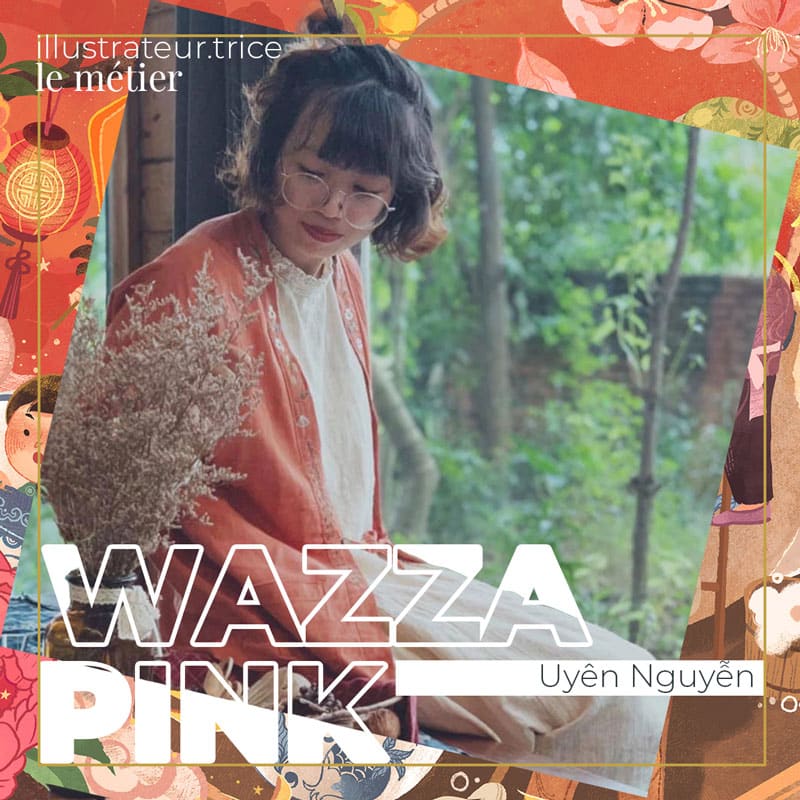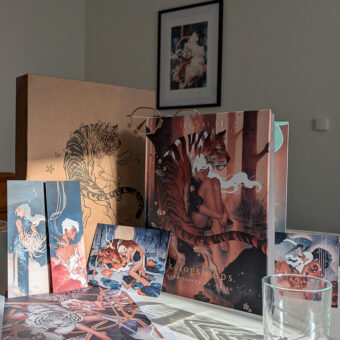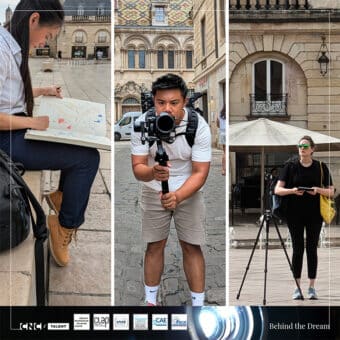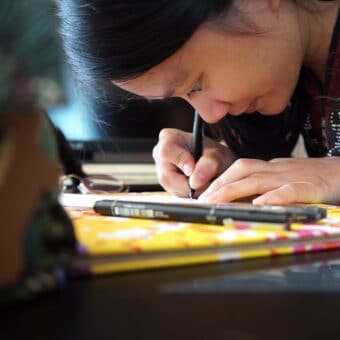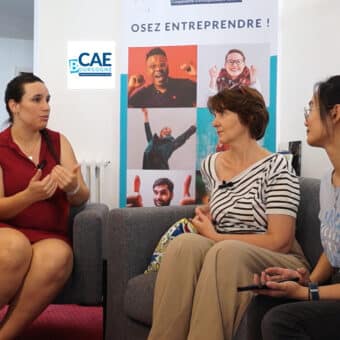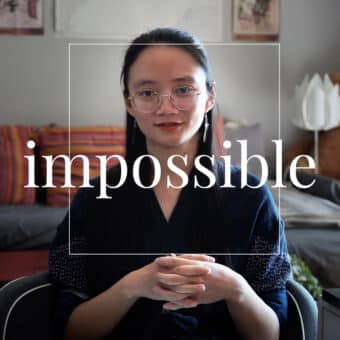Edited by my childhood friend Nguyen Viet Chau Linh
This article is part of the special series “Illustrator: the profession“, where you will find the answers to the questions you most frequently ask me about my occupation.
For this special occasion, I invited some talented colleagues to give us their realistic, detailed, and sincere points of view on the trade of illustrator.
Wazza Pink, children’s illustrator, teacher
Wazza Pink is the nickname of Nguyễn Tố Uyên, a Vietnamese illustrator living in Vietnam. She is the illustrator of many children’s books, published internationally. Her works are simultaneously dazzling with colors and filled with the sweetness of a dreamlike universe.
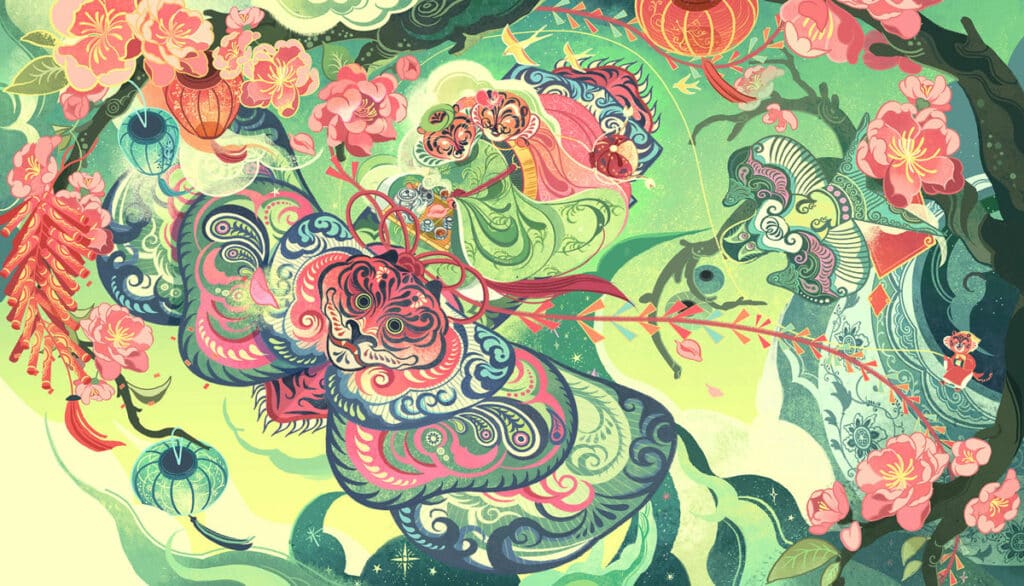
Yet, it was a black and white comics in Vietnamese that introduced me to the work of Wazza Pink. These comics were very famous on Facebook back in 2013, 2014. Years passed, one day, by coincidence, I saw Wazza Pink’s name again on the cover of a sublime children’s book, in the center of Lyon. In an extremely childish way, I wanted to shout in the bookstore: “This illustrator is Vietnamese! She’s a Vietnamese!”
The interview with Wazza Pink was a very down-to-earth conversation. Since Wazza Pink is both an illustrator and a teacher at Art-Workout, she has a concise and well-rounded way of conveying information.
It was only when I was looking for the photos on the internet to edit this article, that I learned that… Uyên is one year younger than me. 😅 In this article, I want to keep the pronoun “chị Uyên” (note: which literally translates to “older sister Uyên”. In this case, the pronoun refers to a woman a few years older than the interviewer, employed with respect.) used in the interview, to keep the spirit of our exchange.
Actually, I think naming “chị Uyên” is a reasonable choice. In the past, in my high school, some teachers were often called “anh” (note: older brother) or “chị” (note: older sister) for the closeness we had with them. To me, the exchange with Wazza Pink felt more like a coaching session with a mentor than a simple interview. Wazza Pink exudes maturity and reliability, which encouraged me to share my own concerns.
In this article, in addition to the concrete and informative answers, you will discover the observations of a newbie illustrator, contrasted with the experience of a known and experienced illustrator.
(note:
- In reality, the pronoun “chị Uyên” is only visible in the Vietnamese version of this article. Its use does not impact the content of the French or English version.
- In the article, the word “the job” refers to “the client project”. The term “job” is the official term used in the illustration community in Vietnam).
Meet the artist
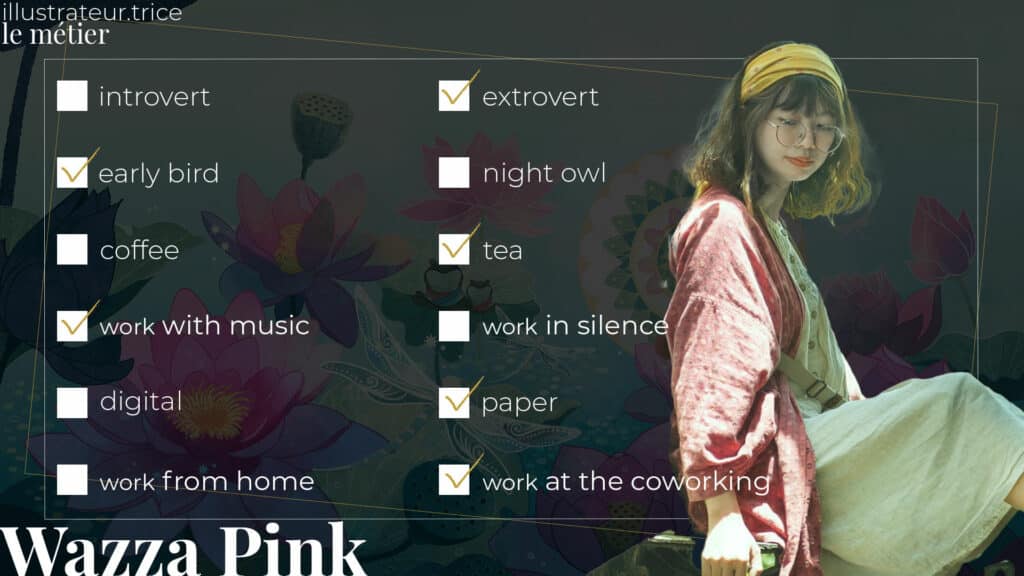
Table of contents
Here is the table of contents, to facilitate your reading, rereading, and future research:
What is illustration?
An: How would you describe your work?
Uyên: I mainly illustrate children’s books. This is only a very small part of the profession of illustrator. From time to time, I also create illustrations for advertising.
When I illustrate children’s books, my target is children. But when I illustrate for advertising, the target audience may be older. However, the drawing style does not vary much between assignments. When clients choose me, they have already consulted my illustrations to make sure that the style suits their audience.
That’s the description of the illustration work that I’m doing. But the concept of illustration itself is very broad. It’s not just children’s illustration or adult illustration. Every time we draw to reach a specific target, we are doing the work of an illustrator.
Illustrators’ « start-up »
Drawing the comics before starting the illustration
An: How did you get started as an illustrator?
Uyên: At first, I had no intention of pursuing a career in illustration. I studied Foreign Languages.
In fact, at that time, I thought that it was a difficult profession. I was still very young, my world view was very narrow.
When I started, I didn’t even have a clear vision about illustration. I just had a short course in drawing, and then I joined a communication company for a student job. My job at that time was to draw the mini comics.
After a year, the company gave me some jobs illustrating book covers. Those were my first steps in illustration. Then I became a freelancer. At that time, I couldn’t be considered as making a living from my passion. I had the financial support of my family, in addition to commissions from my former company. This allowed me to focus on skill and career development.
Fiverr: the door to becoming an illustrator
An: Which year did you start your activity as an illustrator??
Uyên: I got my first job in 2013. But it was only in late 2014, early 2015 that I started to be able to make a living from it.
In the beginning, I was doing everything related to drawing, even if it wasn’t specifically illustration. I would draw even if the client imposed a style that had nothing to do with mine.
I started with the missions on Fiverr (note: an online platform designed to connect companies or individuals with freelancers). At that time, I created an account to offer services related to drawing. There were four or five of us illustrators working under this same account, this same entity. It was our “start-up”. The word “start-up” sounds fancy, but we were just five freelance illustrators who stuck together.
An: So you were already working with international clients at the time?
Uyên: Exactly. I made my living mainly from Fiverr assignments.
I also had Vietnamese clients, mainly for book cover illustrations. But I didn’t have many, and those jobs were discontinuous.
Temporal and geographical factors in reaching customers
Choose a specific channel according to our region/country/culture
An: I’m just at the beginning of the adventure. I haven’t even been in this business for a year yet. Sometimes, I consider creating an account on Fiverr, Malt, or Crème de la Crème… But I notice that on these platforms, the value, and the rate of new freelancers (and even confirmed freelancers) is really low compared to the price of the marketplace.
If we live in Vietnam and use these platforms, the earnings generated through the platforms can probably cover our living cost. However, when we live in a country with a basic high standard of living, I’m not sure this is a good strategy to earn a living.
Uyên: If you don’t use the platforms, how do you find your client missions??
An: I contact clients (publishers or magazines) directly. I send e-mails with my illustrations, and suggestions for possible projects that we could develop together. I also work with private clients.
Uyên: It’s a good thing, if you have the ability to contact publishers and brands directly.
In Vietnam, it is almost impossible to approach the clients directly. Usually, publishers and agencies ignore proposals from illustrators. When I started, neither I nor anyone in my group wanted to sell our service with such low prices. But we didn’t have any other choice.
It’s really great when clients respond to your proposals.
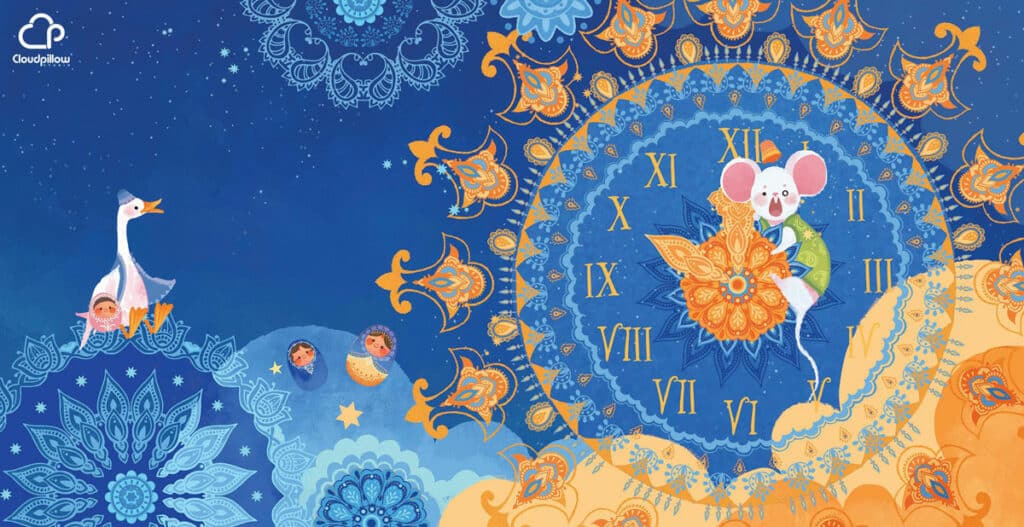
Facebook was a stepping-stone
An: In fact, the number of responses I have received is really low. I’m afraid that after reading this, readers will be discouraged… I feel like I must have sent a hundred emails to get ONE response.
Uyên: That’s quite an achievement! The fact that you are proactive and take the initiative to contact publishers and agencies is already a great freelance mentality.
That said, I, and my generation of illustrators, were lucky! As you knew, around 2013, 2014, Facebook was still growing. Back then, a post could reach 1000 to 2000 “likes”, as long as it had a bit of captivating content.
At that time, anyone who drew mini comics, like Thái Mỹ Phương, or Xuân Lan, would reach the top of the trends very quickly. Once we had a fairly stable number of subscribers and interactions, customers would naturally come looking for us.
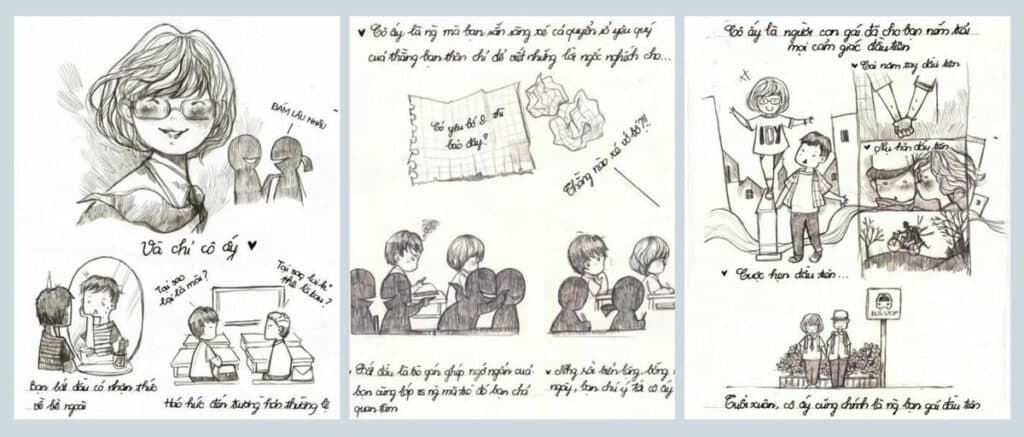
However, today, young illustrators with the same quality of drawing and the same quality of content will certainly not be able to generate the same number of interactions on social networks, at least on Facebook. So you will have to be much more persistent than we were before.
To be honest, since the beginning, I never had to take the initiative to actively look for clients, apart from signing up on freelance platforms like Fiverr or Upwork. My strategy is to develop my personal brand on the different social networks and platforms. Once my portfolio is sufficiently complete, it is the clients that come to me.
Agency: the extension arm
An: As I remember, you have an agency, don’t you?
Uyên: Yes, I have an agency. In fact, in 2018, my agency contacted me by email and asked if I was interested in having them represent me. I voluntarily agreed, just because they promised to bring me jobs. *laugh*
It was once I accepted that I understood that the agency represents the artist on the European and North American markets, and brings to the artists the offers of missions from the clients of this geographical zone.
An: Your agency has been useful in your career development?
Uyên: I must admit that my agency has changed my life! In the international market, publishers rarely work directly with illustrators. Prestigious and well-paid missions rarely reach the artists, but mainly through agencies.
In general, the agency can increase the value of your book up to 10 times.
Freelancer: juggling between “busy as hell” et “bored to death”
An: You are also a teacher, aren’t you? Your Facebook is also very active. How do you organize between drawing, teaching, social media interaction and your personal life?
Uyên: As you know, freelance life is a compilation of busy as hell and bored to death.
When work takes over with emergencies and crises, I do nothing but draw. There are days when I spend 16 to 18 hours drawing. So, it’s my husband who takes care of the family.
In parallel with the activity of illustrator, I am a teacher at Art-Workout. I usually only teach two sessions a week for one class. The most I did was to teach two classes, which meant 4 sessions per week. Compared to other teachers at the same center, my teaching time is minimal.
I don’t teach a lot of classes, so I don’t spend as much time on this as on other tasks. Usually we just have to correct the students’ homework, and again, it depends on whether they do it or not.
An: There are students who do not do their homework?
Uyên: Of course they do! In a class of 20 students, it’s normal to have at least 10 students who don’t do their homework.
Most of the time, people take art classes to express their imagination, not to learn how to build a career. Those who study just for fun will feel that the program taught by our center is a bit heavy. People come to relax, if they don’t feel relaxed, they won’t do their homework.
As for those who want to learn for the purpose of working in illustration, or to gain knowledge, they are very diligent. Therefore, their results at the end of the course are very satisfying.
When I have more flexible periods, I start personal projects or participate in community projects. In these cases, my time for drawing often varies between 8 and 10 hours. I spend the rest of the time with my family, helping my daughter with her homework, going on outings with my daughter, or my family. Besides, I take some time for myself.
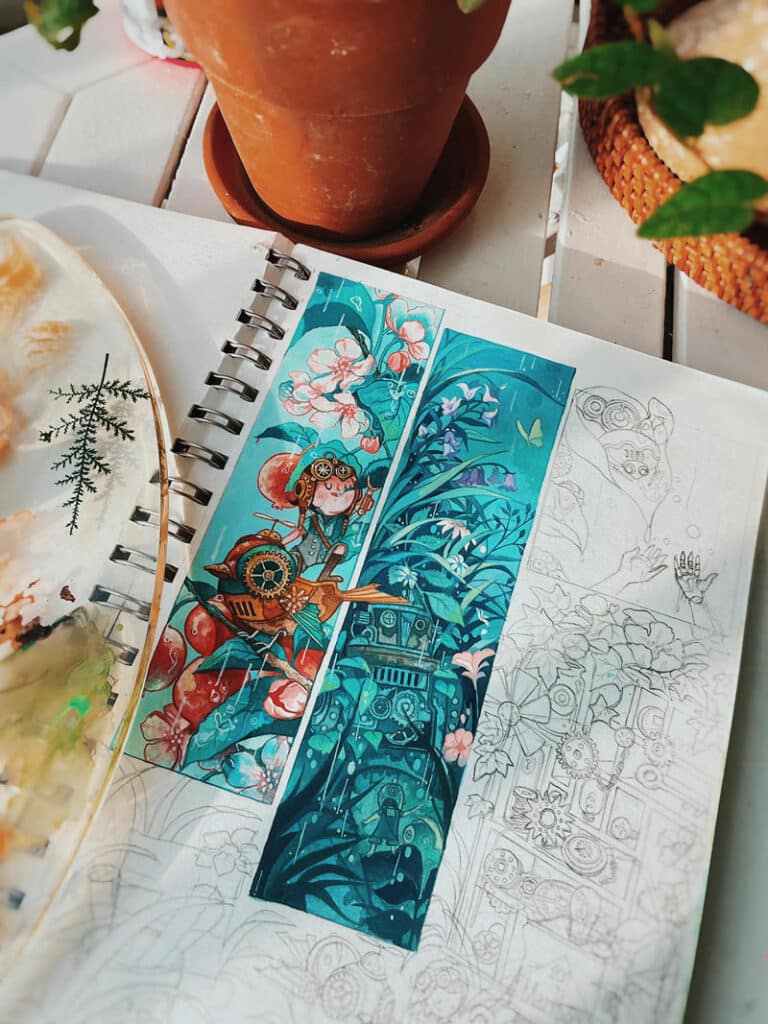
But in reality, my “alone time” is minuscule. I recharge my energy by going out with my friends and family. It’s hard for me to feel happy being alone.
If I have to define my extroversion, I would say that instead of staying at home to work, I will go to the studio, to work while talking with my colleagues. When not working, I would rather go somewhere with a friend from high school, or with my studio colleagues, or with my family, instead of just being alone.
Culture: a grey zone
The “cheap labor” mentality and the double standard
An: Do you think that being a woman, or an Asian, is an advantage or an inconvenience when working with international clients?
Uyên: From my experiences, I don’t see any impact on my job due to my gender.
However, being Asian, or more specifically being Vietnamese, is a problematic issue. Many clients from Europe or North America have a limited budget when negotiating contracts with Southeast Asian illustrators like us.
They consider our country to be in the lower end of development, so they offer a rate much lower than the real value they should pay to artists coming from their country.
I have even received rude remarks, such as, “Why do you charge such a high price when you are Vietnamese?” I think this is an inconvenience we have to face sometimes. People often expect Asians, or more specifically Southeast Asians like me, to accept prices below market value.
An: In recent years, I feel that books and advertising campaigns in European countries, in North America, especially in the United States, focus a lot on diversity, on the fight for equal rights between all ethnicities, genders, groups of people.
Publishers and brands are asking artists to represent different skin colors, different body types and different genders as much as possible. But doesn’t your sharing about how international clients are looking to developing countries for “cheap labor” go against the global trend?
Uyên: Of course, this type of customer is only a part of the market. It is the double standard that some brands, some people convey.
There are contents, and campaigns created and promoted for the unique purpose of generating profits for those who hold the reins behind. Cultural diversity and ethnic diversity will help them attract more consumers.
But of course, there are still people who sincerely wish that this equality will be achieved one day.
Multi-cultural illustration: The rope walking challenge
An: Regarding the composition of the illustrations, did you receive requirements on the presence of ethnic diversity or diversity of morphology for the characters?
Uyên: I think that’s a pretty basic requirement today.
For example, I just designed a book called Happiness around the world. The text is about the world, ethnicities and different cultures. Of course I had to make sure that I clearly represented the identifying characteristics of the characters from each country.
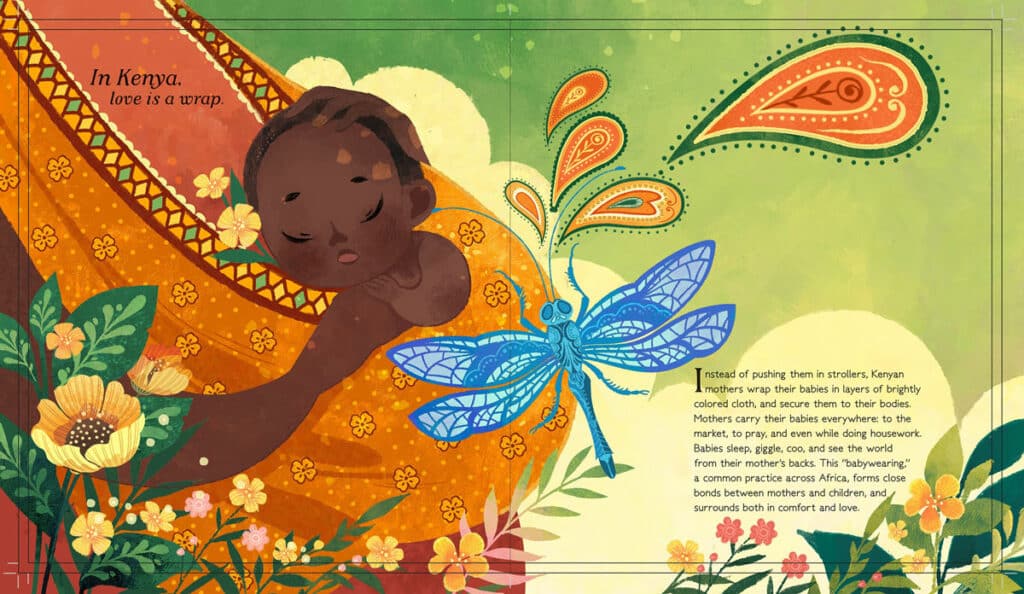
For example, I am asked to draw a bigger nose, more pronounced lips for black people. For Asians, their skin color should not be too light. On the pages where we see several characters coming from different ethnicities, I should clearly illustrate their distinctive characteristics.
An: A few months ago, I created family drawings for several private clients, some of them are Asian. My clients were very happy with the result, they said that the illustrations looked a lot like them.
However, when I made a collage of all the illustrations, a friend remarked, “An, I feel like there’s a problem … you’re only drawing white characters.” My friend had never seen the clients I work with, she’s European, and she’s also very kind-hearted.
However, my characters are mostly… “yellow”. The clients themselves have said that the characters look like them in real life.
So I wonder how to create a balance, so that those who look at my illustration immediately realize that it is an Asian, or an African, without falling into the stereotype that Asians must have “yellow” skin, with wrinkled eyes, or Africans must be burly, with thick lips…
Uyên: I think I’d better go back to the definition of illustration that I quoted to you at the beginning.
There will always be a specific audience that you need to target when you create an illustration. Your illustration must be accepted, understood and appreciated by this target audience.
As for people like your friend, for example, they may have unconsciously held onto clichés about people of other ethnicities. Maybe they don’t have any knowledge about your target. You don’t need to worry about that.
You only need to correct your style in case you feel that there is a problem yourself. But “correcting” here means finding a way to reconcile the needs of your clients with your style. That’s just my opinion on what you’re saying. But otherwise, I don’t normally think about it too much.
You’re also familiar with the term cultural appropriation, right? Culture is a grey area. Sometimes an artist is accused of black-washing, white-washing or cultural appropriation because of a detail… It’s easy to criticize. Often, the public doesn’t see all the research you or I did, the references we based ourselves on, or the people we consulted. But in culture, there is no right or wrong, no black or white. Even in the case where we hold in our hands all the evidence, documents or references, where we are 99.9% certain, we are still likely to get criticism.
In conclusion, you can’t satisfy everyone. The only person you have to satisfy is your target client. The essential thing is already in the definition of the illustration.
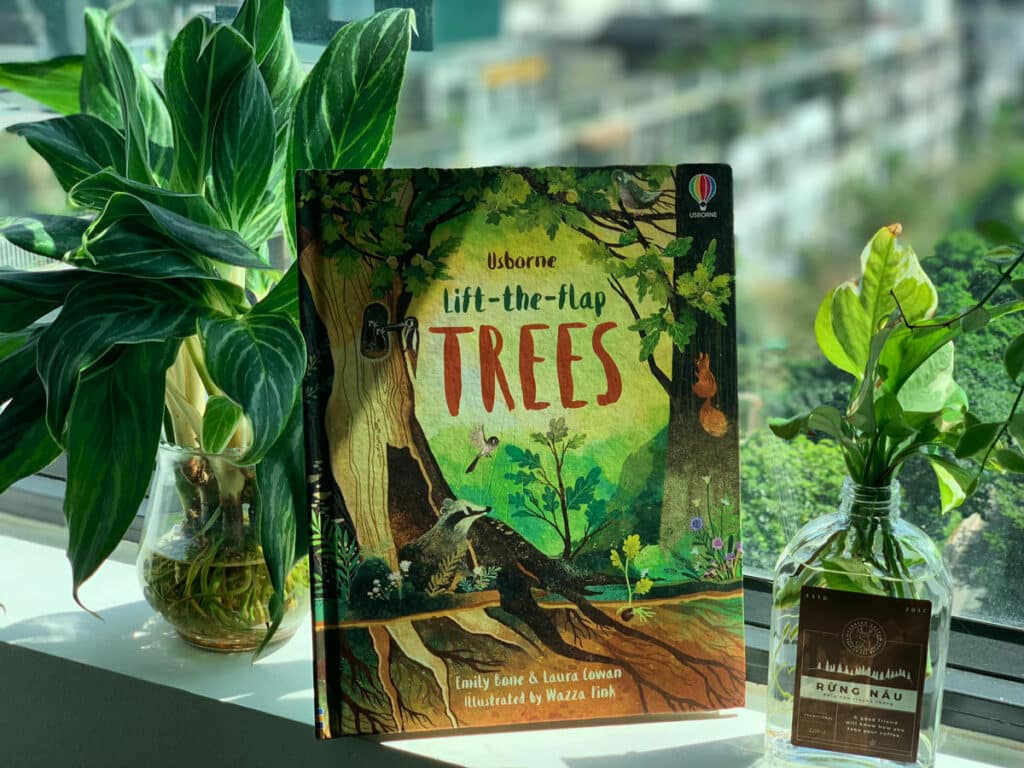
Pride is a relative concept
The eternal child and the respect with the job
An: What makes you proud the most, related to your profession?
Uyên: It’s… complicated. My pride sometimes stems from a lack of confidence in me. My work has a strong connection to the childhood world. So I don’t have to act like a grown-up.
This makes me very proud. Especially when I observe my friends going to the office every morning, and suffering from administrative tasks in the adult world. But at the same time, I feel depreciated, because I feel like I will never grow up.
An: It’s so true! I used to work in a very formal environment. Although I don’t have to wear a mask to hide my personality, I had to be careful about how I dressed, how I walked, how I talked. Plus, I’m Asian, I’m short, I have the look of a trainee, so I had to keep a serious expression, so that colleagues would notice my maturity.
Since I work in illustration, I don’t have to force myself anymore. Even though I’m constantly running behind deadlines for client projects, I still feel happy.
Uyên: Absolutely! With this job, I feel like my life is rose-colored compared to other jobs.
But of course, we don’t have to be “serious” by keeping a rigid attitude, or putting on uniforms. But a serious attitude towards the profession is always necessary.
No matter what the job is, even as a children’s illustrator, we must always respect our profession, and work studiously, so that the work has meaning.
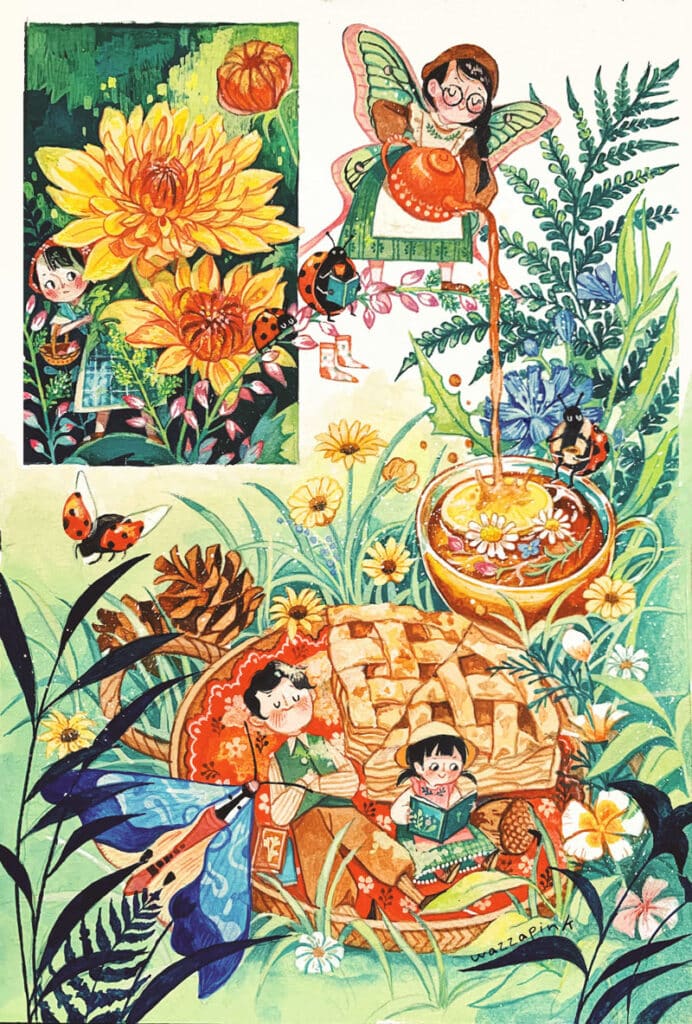
The timing of the compliment is everything
An: Is there any feedback that has made you wonderfully happy?
Uyên: In fact, I have received many comments that I can consider glorious compliments, praising my work. But if those comments come right when I’m feeling sad, depressed or during an artblock… then it touches me much more and makes me fully happy.
Sometimes when I feel stuck with work, I just check out Behance to read the comments. Occasionally, I get comments from strangers, living abroad, like, “Your works cheer me up and give me motivation to get through the tough times.” I am grateful for these words.
Sometimes, there are also clients who text me, saying, “Thanks to you, my work has become much easier!” I also feel very happy.
These phrases give me joy for a whole day, even a whole week. Then, afterwards, I go back to reality with my artblock and my stomach aches. *laughs*
Source of happiness
An: Among all your projects and activities, which one brings you the most income? Is it also your main source of happiness?
Uyên: If money defines happiness, then yes, it is the work that brings in the most money that makes me happiest. * laughs*
Recently, I finished a job creating digital stickers for Facebook. It was by far the biggest source of income for me, out of all the jobs I’ve done. I also learned new things, it was rewarding and fun.
But the jobs that brings me the most happiness are the ones that mark my own development. Their level of difficulty is acceptable, their value is appropriate to the effort I put into them. Like the book Happiness around the world that I just drew. By the way, the title alone makes us happy already.
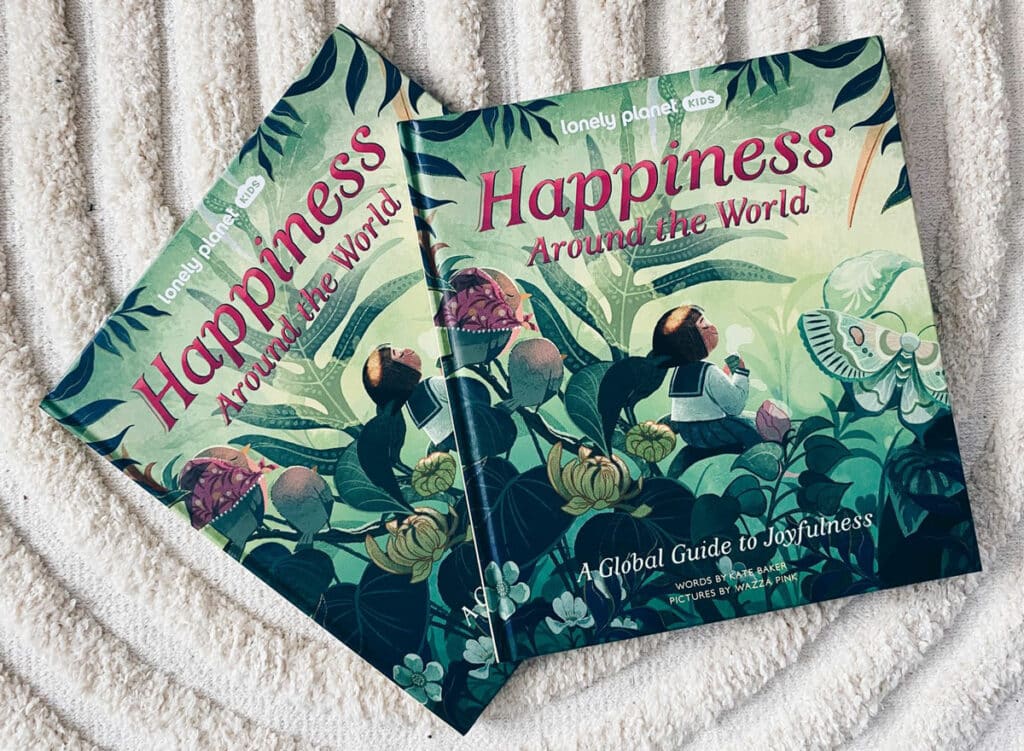
I tend to feel overwhelmed when I have too much work to handle. In the beginning, I may put in a lot of effort. But after my time and energy has been consumed, my motivation and excitement from the beginning definitely decrease. So, a job that contains 10 to 15 illustrations to complete is the ideal. At the same time, the level of technical difficulty should be neither insurmountable, nor too easy.
Low-budget jobs with few requirements, where clients only need a single illustration to get published, will not help me to progress, nor to build my personal brand. These jobs can’t bring me as much happiness as jobs that offer me freedom and opportunity to grow.
When the dream fades away
An: Author Elizabeth Gilbert has mentioned the concept of sh*t sandwich in her book Big Magic. Generally, the public only sees the benefits and the dreamy, light-hearted side when looking at creative professions. But every profession has its own sh*t sandwich, which only those who practice it can understand.
Have you noticed any dark and painful sh*t sandwich related to the profession that the public has trouble understanding?
Uyên: Actually, all illustrators, and even all freelancers, feel that what gives us freedom would be, at the same time, the biggest hurdle.
You do the work of your dream. But then it ruins you. You draw every day, but not for yourself, nor for pleasure. You have real clients. These people ask you to draw A, you have to draw A. These people ask you to draw B, you’ll draw B. Even if they keep change their mind, you’ll keep smiling, and you’ll follow their direction, because you need to make a living.
I think that’s the reality for everyone who works in the service industry, not just designers, or illustrators.
But our profession is a bit special, because it is based on our passion, the passion for drawing. The passion will gradually fade away, when we start drawing like a technician, devoting our day, our health, our imagination to capitalism. This is why some people are prone to artblock after getting too caught up in the cogs of making a living.
To keep our personal and artistic identity, and the love for drawing, sometimes we have to stop. Maybe we’ll be hungry, very hungry indeed. But anyway, it’s impossible to move forward with a burn-out on your back. So I prefer to be hungry for a month or two, and take the time to rest, and work on personal projects, and then come back with my will and my passion.
It is the torment, and the effort to get as many jobs as possible, that wears us down. It’s the ultimate difficulty in our profession of illustrator.
Is AI a threat?
An: Recently, an American won first prize in the Colorado State Fair art competition with a piece of art made entirely with the help of artificial intelligence (AI).
Do you feel that AI will become a threat to our profession?
Uyên: To say that this does not affect our profession is a big lie.
But I think that until now, and even, in the next decades, AI will probably not be able to completely replace humans.
To have AI produce a complete work, from start to finish, without the help of artists, we still have to wait for the next technological developments. And it depends on the clients’s awareness. But the thoughts and intentions that an artist puts into his or her work will never be entirely replaceable.
In the past, in the industry, we also debated between the place of traditional drawing and digital drawing. And then, even today, traditional illustration is still not completely replaced by digital. Although digital is more convenient, and better suited for printing and publishing. Yet many artists around the world continue to use traditional materials to create. There are still clients who demand and cherish the authenticity of traditional works.
University studies in art VS self-taught
An: Do you think that those who are trained in illustration in the university environment have an uncontestable advantage in the profession of illustrator?
Uyên: I find that superiority does not depend on whether you have a university education or not, but on how you spend your time in practice.
Here I am only talking about serious people who respect the profession. Of course, there are many advantages to a university education. The technical foundations of former art students are often much stronger than those of self-taught artists. They have teachers to guide them. Those who study art abroad have the opportunity to immerse themselves in an environment that stimulates creativity. Most importantly, having a time and environment dedicated solely to study is much more comfortable than working as a salaried employee while training on the side.
Of course those who are truly passionate about drawing will always seek to actively develop themselves, even when they already have a full-time job. And they will continue to progress. But without a reliable guide, their path is likely to be longer and trickier. Sometimes we finish an illustration and find it wobbly, not knowing where the error lies. The teachers are there to point out the error. And often, right from the start, they show us how to avoid these mistakes. We save a lot of time by taking courses.
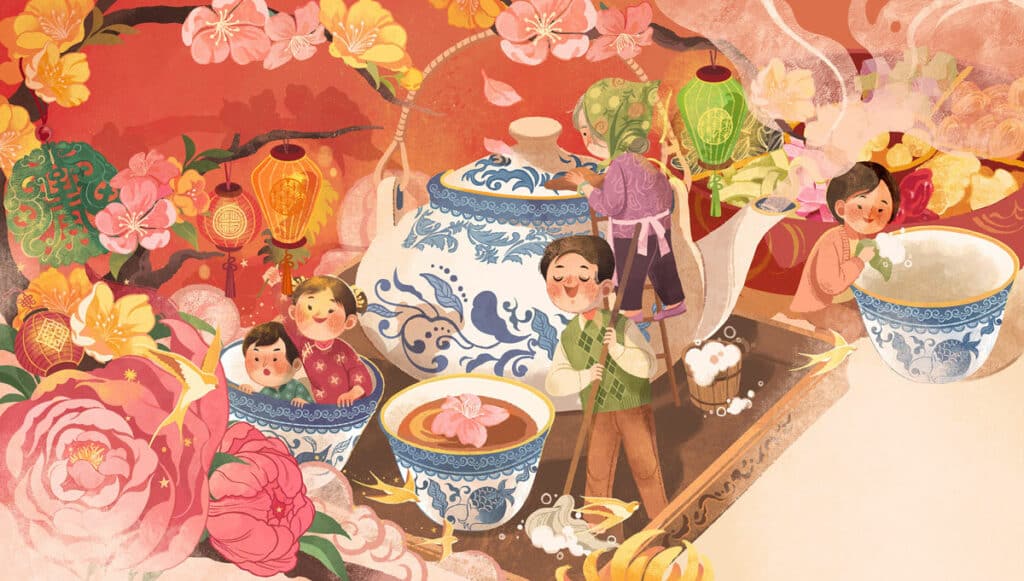
Tariff and value: the eternal isue
An: In our profession of illustrator, remuneration and fees vary according to several criteria. There is no universal formula that applies to all cases.
Do you have any suggestions for documents or resources to help young illustrators determine value and fees in a fair and equitable manner?
Uyên: I just learn from experience after experience. I think it’s hard to have a universal document to rely on.
For those of you who are just starting out in the business, who are afraid of scaring off customers with a high price, or breaking the market with the low price, I think the best way is to simply give the price that you feel is right for your own value. You will adjust with experience.
Sometimes I honestly ask clients what their budget is. Sometimes they refuse to answer, and then, when I give my price, they disappear. That’s normal in this industry. It doesn’t just happen to the newbie. I’ve been in this business for almost 10 years and I still have to deal with this.
Some artists share their experiences on Facebook related to rate estimation. Like Hiếu Châu, he made a very complete post about illustration pricing. But I find it a bit difficult to apply his advice, because the value of his services is very high, since he has much more experiences than me, and he is very famous.
But the sharing from colleagues always remain relevant and useful references.
An: I think the way clients respond also shows how serious they are about the project. If they give a budget, no matter how high or low it is, I know they have already prepared a budget. If they can’t give an amount, in most cases it’s because they don’t have one. It won’t be a surprise if they disappear.
Uyên: From experience, they often ask several illustrators for a price. Then they choose the one who announces a price that is closest to the amount they have in mind.
Maybe they are not serious. But they are not serious only with us. In general, they are afraid of committing themselves to an unprofitable collaboration, and in reality, so are we.
First, you have to be serious with your passion
An: In your opinion, what is the most important thing to start with in illustration?
Uyên: First of all, of course, we have to love our job. The more passion we have, the easier it will be in the beginning, we won’t have to worry too much. People keep saying that passion doesn’t guarantee a living, and that the cost of living keeps increasing. But I know people who live a very simple and basic life, to follow their passion. And they are happy.
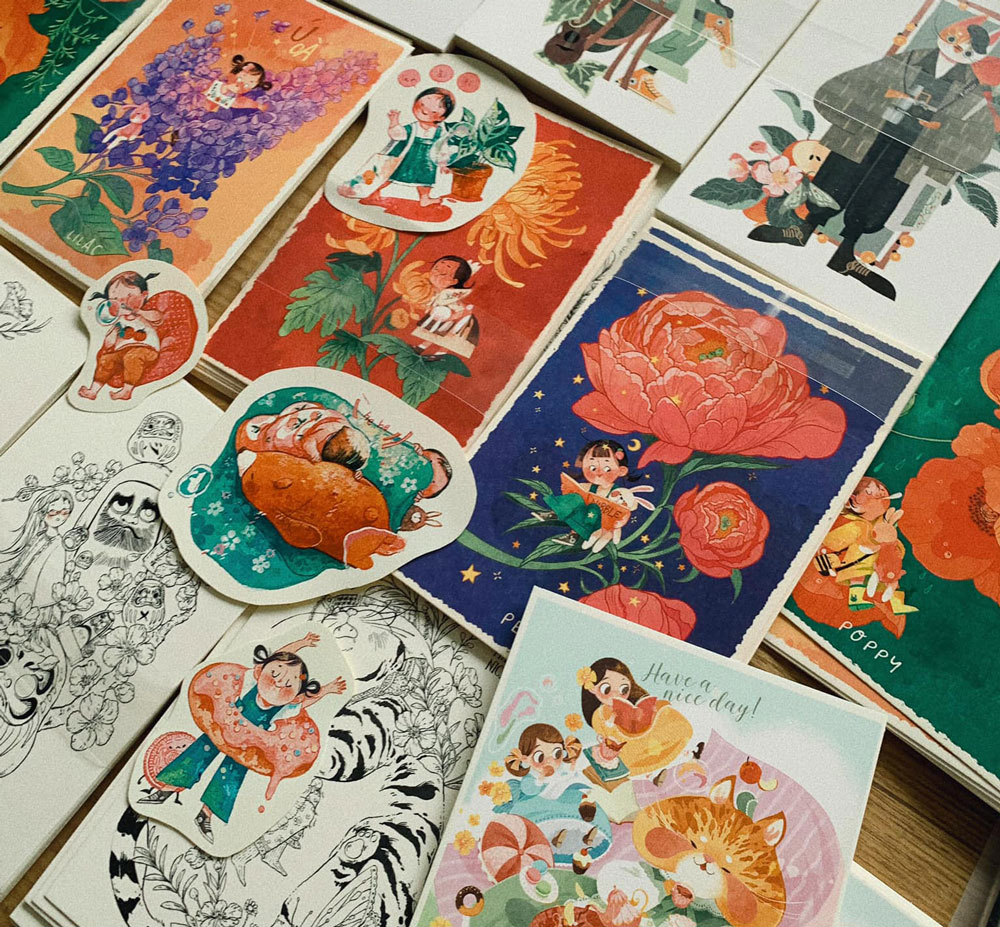
An: If you have one last piece of advice for those who are about to start, or who wish to become an illustrator, what would it be? Do you have a word to share with their families in case their families disagree with their life choice?
Uyên: In fact, I’ve watched several people who opposed their parents, who left everything to follow the profession of illustrator. But in the end, they didn’t feel like they belonged to it, and they gave up that path. Maybe because the passion wasn’t enough, it wasn’t strong enough for the person to hold on to at all costs.
But the advice I want to give to those whose passion is big enough is that it is necessary to be serious and hardworking, to follow this profession in the long run.
This is applicable to any other profession. If we start with the superficial idea that this job is easy, we may fail very quickly. Imagine, you were an accountant, you were fed up with calculations, you looked at illustrators thinking that their job seemed light and pleasant, so you started as an illustrator… In this case, you would fall down quickly.
As for the families who oppose the choices of their children… In fact, the more we protest, the more our children want to get the forbidden thing, and this is valid in all aspects, not only in their career. It is as if the more we forbid the child to fall in love, the faster he or she will get into a relationship. So, just let your child test. Sometimes they realize on their own that this is not the right path for them.
But I am not sure that this profession deserves so much fear from parents. We can live quite comfortably as illustrators. Of course, the number of illustrators living in abundance and wealth is quite small, unlike the commercial careers. But I have noticed that most illustrators who are serious about following this path manage to make a living from their profession.
The realistic dream
An: Do you have a project that is dear to your heart, or a dream that you wish to accomplish, in the short or long-term future?
Uyên: In the far future, I still wish I had twenty billion VND! *laughs*
As for the near future… In the past, I already have the book Nhật ký của Pink (note: Pink’s diary), published in Vietnam. In the near future, I would also like to publish another book abroad.
Regarding picture books, I would like to publish a book in which I will be both author and illustrator.
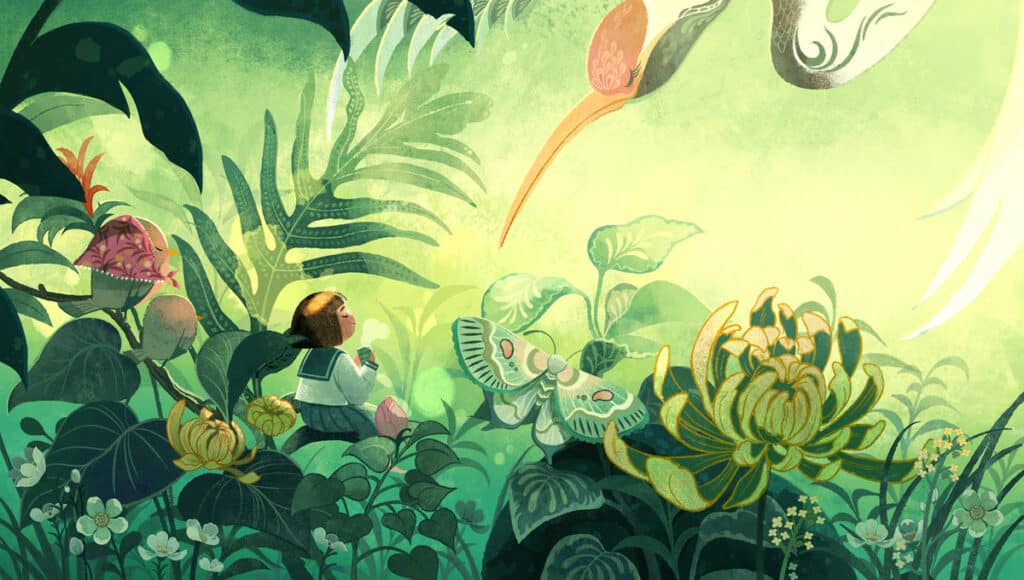
You can follow Wazza Pink on Facebook Wazza Pink, or Instagram wazza_pink
Giveaway
For this first special series in the blog, I would like to offer a package with 5 artworks, from each guest of this special series, to one lucky person among you.
If you want to participate in the giveaway, here is the link: https://forms.gle/Zr1zUMSQZsxfgPKk7
I’m also planning 1 surprise gift for each participant of the giveaway!
Let’s be serious with our passion & Keep creating!
Tu Ha An
*Please consult the information on Copyright & Intellectual Property before copying or mentioning the content and images of tuhaan.com



